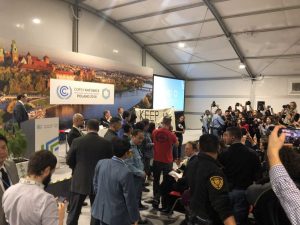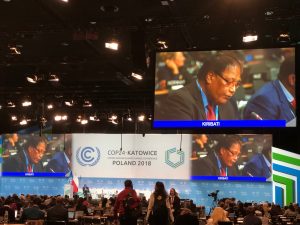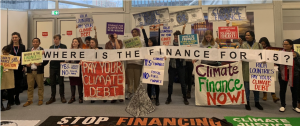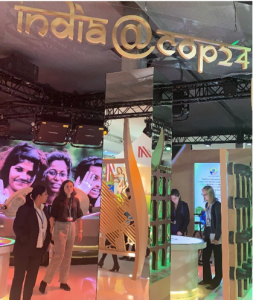Jacob Glasser
My first day at the COP was both fantastic and overwhelming. Walking into the UFO-shaped venue to thousands of people all convening to work on climate change was incredibly inspiring. I heard languages from all across the globe as I navigated my way through an unbelievable number of events, meetings, and booths.
Today I focused mostly on “just transition,” which is all about the necessary transition to a clean carbon economy and how we can protect those who lose their livelihood in the process. After listening to the COP21 Paris President, former World Bank Chief Economist, the head of the Indonesian delegation, and Ministers of Environment from South Africa, Spain, and Scotland, I have realized there are many points everyone agrees on. If you understand the challenges and the opportunities, a just transition can be incredibly rewarding. Hundreds of thousands of premature deaths can be prevented, trillions of dollars are available, and tens of millions of jobs can be created. It was interesting to hear a diverse array of people all voice their concerns, but the solutions I heard today left me feeling optimistic.

I was also present for the US side-event promoting fossil fuels. I still haven’t fully processed what I witnessed, but it is extremely disheartening to watch my country be literally laughed at on the global stage. I was embarrassed to be American, and I am sporting my “We are Still In” pin proudly.
Molly Bruce
Dear Costa Rica and New Zealand,
This is a story about why I love you both.
Of all the countries I became more familiar with today, you were both by far the best. Your representatives, Monica Araya—Founder and Executive Director of Costa Rica Limpia—and Stephanie Lee—the New Zealand Minister of Foreign Affairs & Trade—were beacons of hope for a world that needs more ambitious national commitments to minimize greenhouse gas emissions (GHGs).
Costa Rica, you’ve pushed forward morally sound environmental initiatives in the face of a world filled with climate-action fossils. You’ve announced plans to ban fossil fuels, have committed to being carbon neutral by 2021, and already you source 99% of your energy from renewables. You’ve imposed a moratorium on oil extraction that persists through 2021, and most of your energy grid is sourced from hydropower. If more global actors adopted your level of ambition, our NDPs would get us much closer to our 1.5-2.0 degree goal rather than our current trajectory of global warming in the 2.6-3.2 neighborhood.
And New Zealand, you’re an inspiring example of a country working toward a carbon-neutral future despite a resilient and powerful domestic oil industry. As of 2016, only 40% of your energy was sourced from renewables, as opposed to Costa Rica’s 99%. Furthermore, you currently accrue $2.5 billion or 1% of your economy annually from the oil industry. However, in May 2018, you took the bold step of banning new deep-sea oil and gas development permits. This also means that the 22 permits already in existence will expire in 2030, with the caveat that these permits could be extended an additional 40 years under certain circumstances. Though there is much work left to be done, you are an example to the rest of the world for why we should not put off the inevitable need to act more aggressively to mitigate climate change.
XOXO,
Molly
https://www.globalcitizen.org/en/content/costa-ricas-new-president-banned-fossil-fuels/
https://www.cnbc.com/2018/04/12/new-zealand-set-to-ban-oil-and-gas-drilling.html
Rosanne Lam
First day of week 2 was an absolute blur. Since I purchased 5 CERs (Certified Emission Reductions), aka 5 tonnes CO2e, towards a methane capture and combustion from swine manure treatment project through the UN carbon offset platform, I received a fun white lanyard at registration. Today was the final day of the #WeAreStillIn pavilion, the first day of week 2, as well as the apparent difference in size and grandiose compared to COP23 and years before. At #WeAreStillIn’s event on what US Intent to Withdraw Means to The Paris Agreement, Sue Biniaz (lead climate lawyer of US State Dept for more than 25yrs) and Todd Stern (US Special Envoy for Climate Change) engaged in a dialogue with each other and speculated that while the finalization of the Paris Rulebook is critical, a separate signal to the public of mutual trust between countries would highly increase climate ambition. Additionally, they mentioned the highly technical, difficult, and wide array of issues necessary to be negotiated was a major source of challenges that ministries, delegates, countries are facing on the communication front.
An optimistic point of my day was the successful launch of the Fashion Industry Charter for Climate Action, the official charter can be accessed here. The 21 founding signatories, including Burberry, Hugo Boss, Adidas, H&M, and Target, amongst other companies and organizations, have committed to the goal of 30% aggregate GHG emissions reduction by 2030 as a starting point, with a goal of complete decarbonization pathway for the entire fashion sector. This was a highly interesting special event to attend, especially considering my interest in the fashion industry and its alignment with the SDGs/social, ethical, and environmentally sustainable growth. Seeing Patricia Espinosa, the Secretary General UNFCCC, give a speech at the end congratulating the signatories was the icing on top. The charter decided to use the Higg Index, a tool for transparency in sustainability reporting provided by the Sustainable Apparel Coalition, to track its progress.
Emily Millar
Today I got to meet the Climate Analytics team, who I will be working with all week, become VERY familiar with the printing room, attend the U.S. side event on fossil fuels and nuclear energy, attend the Climate Finance Plenary, and try a rose jelly filled donut. The U.S. side event was a surreal experience. Hosted by Wells Griffith, the Principal Deputy Assistant Secretary for the Office of International Affairs, this event which featured Assistant Secretary for Fossil Energy Steve Winberg, Australian Ambassador for the Environment Patrick Suckling, Executive director of ClearPath Rich Powell, and Director of Commercial and Development at Sempra LNG & Midstream Asfaha Tesfai focused on natural gas and coal innovation in the U.S. and Australia. Not long after Griffith began his opening statement, the event was punctuated by a protest demanding they “keep it in the ground!” After the protest, the room—which had been so full in the beginning that many people had to be turned away—cleared out. The panel continued on, mostly discussing all the new technologies being used to uncover fossil fuel reserves. While the event was definitely discouraging from a climate perspective, my peers were reminded today at an even featuring Todd Stern that the actions and motivations of the U.S. negotiators are not aligned with these anti-environment attitudes being spotlighted at side events.
Youngwoo Kim
Today, I have been in three climate sessions. First, the World Bank Group organized “Scaling-Up Climate Action in Europe and Central Asia”. Panelists from European Bank for Reconstruction and Development (EBRD), European Investment Bank (EIB), the World Bank emphasized integrated approach between economy and environment issues. On the other hand, the Minister of Nature Protection of Armenia agreed to not only enlarging investment, but he also stressed out capacity building of people is very critical in developing countries to keep the resilience to climate change.

In the high-level climate finance dialogue, I could listen to many leaders’ opinions. Several ministers from developing and developed countries, leaders in international organizations, and experts from private sector shared their ideas. Some developed countries’ national leaders from Swiss and Sweden pledged their new supports to Adaptation Fund and Least Developed Countries Fund. In the dialogue, especially, I was impressed that the comment from the Executive Director ad interim at GCF, Javier Manzanares, “Capacity, Capacity, Capacity”. This is voice from the developing countries, which was overlapped with the Armenian minister’s comment.
At the end of the day, I also have been in the Multilateral Development Bank (MDB)s’ Talk “$200 Billion From 2021-2025: The World Bank Group and Climate Action”. Professor Nicholas Stern mentioned about the importance of role of public finance, which can mobilize private finance, above its volume itself. For the first day of COP 24 in the second week, I could reconfirm two important things about public climate finance as a mobilizer for private finance and a source of developing human capacity.
Aashna Aggarwal
While the world celebrates Human Rights Day, the theme for COP24 today was Climate Finance. What’s my dream for Human Rights if you may ask, would where people have the right to a clean, climate change free future.

Climate finance is super important because you need expenditure decisions in almost everything you do. The Plenary Session on climate finance reinforced the need for a long-term plan and strategy while rebuilding infrastructure for cities being affected by severe weather conditions in the short term. It is important to have clarity and predictability of available financial resources and sustainable implementation of policies.
The rest of the day I navigated the country pavilions and attended some side events. The US climate action center “#WeAreStillIn” had panel discussions throughout the day talking about non-state actors and role of cities and their commitments in resolving climate change. California plans to be more involved in linkages on oceans and climate change and also have a state determined contribution of California in the next few years.

As a part of my work with the US Green Building Council I attended events at the US and Indian Pavilions about Energy Efficiency in Buildings through innovations in cooling technologies, new building codes for residential housing and mitigation of super potent gases like HFCs. It was really interesting to see the difference in priorities between the two countries. The equity issues in India makes the government think more about the issue of providing thermal comfort to citizens while keeping the houses affordable. The US panel discussed more about the different building standards and the role of technology and science to find an alternative for HFC’s. The audience brought up discussions about energy efficiency vs sufficiency.
The day ended with spectating the delegate of Austria receive the “Fossil of the Day” award. He proudly gave a thank you speech with a smile on his face while he said they would forever remember this December gathering where they supported fossil fuel subsidies until 2035. Well, you could have done better @Austria.
Dieynabou Barry
Today’s theme for the COP was “Just Transition and SDG 8”. (SDG 8 is decent work and economic growth). I attended a few events wherein panelists spoke about what it means to ensure a just transition as it relates to economic development and jobs. The panelists all emphasized that when it comes to creating climate change policy, governments should be aware of how workers and jobs will be impacted. Aligning with the theme of the day, the panelists put jobs and economic development first and seemingly pushed aside the climate change policy. I was a bit surprised by the wording used during these panels because it seemed that the panelists were suggesting that climate change policy should only be implemented if it does not interfere with economic development. I only heard from one panelist who said that when using the Just Transition approach, governments should not be afraid to risk jobs if it means addressing a much bigger problem; governments should strategize on how to minimize the impacts of job loss instead.